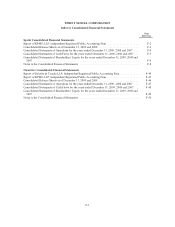Sprint - Nextel 2008 Annual Report Download - page 77
Download and view the complete annual report
Please find page 77 of the 2008 Sprint - Nextel annual report below. You can navigate through the pages in the report by either clicking on the pages listed below, or by using the keyword search tool below to find specific information within the annual report.SPRINT NEXTEL CORPORATION
NOTES TO THE CONSOLIDATED FINANCIAL STATEMENTS
Investments are evaluated for other-than-temporary impairment on a regular basis. Other-than-
temporary impairment occurs when the estimated fair value of an investment is below the carrying value, and the
difference is determined to not be recoverable. This evaluation requires significant judgment regarding, but not
limited to, the severity and duration of the impairment; the ability and intent to hold the securities until recovery;
financial condition, liquidity, and near-term prospects of the issuer, specific events, and other factors.
Long-Lived Asset Impairment
Sprint evaluates long-lived assets, including intangible assets subject to amortization, for impairment
whenever events or changes in circumstances indicate that the carrying amount of an asset group may not be
recoverable. When it is probable that undiscounted future cash flows will not be sufficient to recover an asset
group’s carrying amount, an impairment is determined by the excess of the asset group’s net carrying value over
the estimated fair value. Refer to note 9 for additional information on asset impairments.
Certain assets that have not yet been deployed in the business, including network equipment, cell site
development costs and software in development, are periodically assessed to determine recoverability. Network
equipment and cell site development costs are expensed whenever events or changes in circumstances cause the
Company to conclude the assets are no longer needed to meet management’s strategic network plans and will not
be deployed. Software development costs are expensed when it is no longer probable that the software project
will be deployed. Network equipment that has been removed from the network is also periodically assessed to
determine recoverability. If we continue to have operational challenges, including obtaining and retaining
subscribers, future cash flows of the Company may not be sufficient to recover the carrying value of our wireless
asset group, and we could record asset impairments that are material to Sprint’s consolidated results of operations
and financial condition.
Indefinite-Lived Intangible Assets
Goodwill represents the excess of consideration paid over the estimated fair value of the net tangible
and identifiable intangible assets acquired in business combinations. During the fourth quarter 2009, in
connection with our acquisitions of VMU and iPCS, we recognized goodwill of $373 million, representing the
entire balance of our goodwill as of December 31, 2009. Our indefinite-lived intangible assets include Federal
Communications Commission (FCC) licenses, acquired primarily through FCC auctions and business
combinations, to deploy our wireless services, and certain of our trademarks. In determining whether an
intangible asset, other than goodwill, is indefinite-lived, we consider the expected use of the assets, the regulatory
and economic environment within which they are being used, and the effects of obsolescence on their use. We
assess our indefinite-lived intangible assets for impairment at least annually or, if necessary, more frequently,
whenever events or changes in circumstances indicate the asset may be impaired. Such indicators may include a
sustained, significant decline in our market capitalization since our previous impairment assessment, a significant
decline in our expected future cash flows, a significant adverse change in legal factors or in the business climate,
unanticipated competition, and/or slower growth rates, among others.
Benefit Plans
We provide a defined benefit pension plan and certain other postretirement benefits to certain
employees, and we sponsor a defined contribution plan for all employees. The objective for the investment
portfolio of the pension plan is to achieve a long-term nominal rate of return, net of fees, which exceeds the plans
long-term expected rate of return on investments for funding purposes. To meet this objective, our investment
strategy is governed by an asset allocation policy, whereby a targeted allocation percentage is assigned to each
asset class as follows: 50% to U.S. equities; 15% to international equities; 15% to fixed income investments;
10% to real estate investments; and 10% to other investments including hedge funds. Actual allocations are
allowed to deviate from target allocation percentages by plus or minus 5%.
Investments of the pension plan are measured at fair value on a recurring basis which is determined
using quoted market prices or estimated fair values. As of December 31, 2009, 59% of the investment portfolio
was valued at quoted prices in active markets for identical assets; 26% was valued using quoted prices for similar
F-11
























